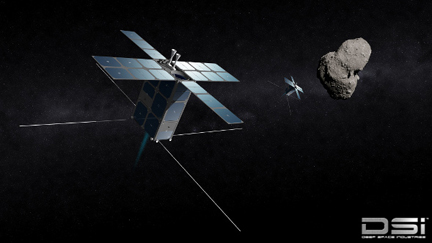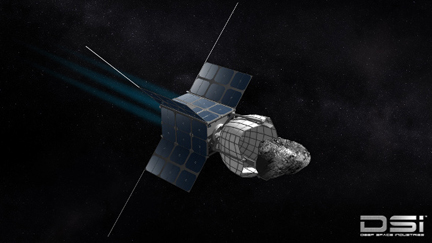Company envisions asteroid mining
01/22/2013 05:13 PM Filed in: Space News | Commercial Space
By WILLIAM HARWOOD
CBS News
Hoping to take the commercialization of space to a higher level, a second company has jumped into what the founders hope will be a lucrative emerging market, prospecting for raw materials among near-Earth asteroids using fleets of low-cost robotic spacecraft, senior executives said Tuesday.
The long-range goal is to develop an in situ manufacturing capability, harvesting raw materials and building components in space using high-tech mini foundries built around sophisticated 3D printers.
"This is about the future. This is about making something happen," company chairman Rick Tumlinson told reporters during a news conference in Santa Monica, Calif. "Deep Space Industries is a space resources company. We are about prospecting, exploring, harvesting, processing and manufacturing based on the resources of space.
"Overall, our business plan, our idea, is to get into this field as it begins. And it is beginning today."
Deep Space Industries plans to begin initial operations in the 2015 by launching a trio of small satellites that will hitch rides to space as secondary payloads on missions to launch communications satellites and other large spacecraft.
The solar powered DSI FireFly spacecraft, equipped with propulsion systems, solar panels and a suite of compact sensors and cameras, then will head off on high-speed one-way trips to selected targets to characterize the makeup of the asteroids in question and their suitability for mining.
The FireFlies will weigh about 55 pounds and be based on designs currently used for low-cost Cubesat missions sponsored by universities and other researchers.
If all goes well, DSI will follow the FireFly deployment with slightly larger DragonFly spacecraft in the 2017 timeframe. Tipping the scales at about 70 pounds, the DragonFlies will be launched on missions lasting two to four years with the goal of retrieving 60 to 150 pounds of asteroid material.
DSI's long range plans include systems to grind up asteroid materials and a "MicroGravity Foundry" using a laser-driven 3D printer to build complex metal components in the absence of gravity.
Company officials did not discuss what it might cost to build and launch the envisioned spacecraft. But they stressed that no radically new technology is required to turn the dream into reality.
"You don't see any magic," said John Mankins, DSI's chief technical officer. "You don't see any space elevators, you don't see anti-gravity, you don't see warp drive. There is nothing in the business plan that Deep Space Industries is pursuing that cannot be done with technology research that has already been accomplished in laboratories across the planet."
While the technologies may not have been used in space, "the fundamental technologies are really at hand and it's really a question more of how to accelerate their application and deployment in a way that makes both scientific and business sense," Mankins said.
In April 2012, another company, Planetary Resources Inc., announced plans to identify near-Earth asteroids loaded with ice, precious metals and other raw materials and then to send robotic landers to selected targets to carry out mining operations.
Planetary Resources is focused on returning valuable ores to Earth or to convert ice into rocket fuel to dramatically lower the cost of space exploration.
Asked if the as-yet untested market could support multiple competitors, Tumlinson said "we all came up together, all of us in the different companies have sort of the same heritage."
"We see it as complimentary competition," he said. "And you know what? One company may be a fluke. Two companies showing up, that's the beginning of an industry. And so what you're witnessing right now is the beginning of a real industry that begins beyond low-Earth orbit.
"We look forward to working together with these guys. They've got slightly different aims than we do, but space is big. There's room for everybody."
CBS News
Hoping to take the commercialization of space to a higher level, a second company has jumped into what the founders hope will be a lucrative emerging market, prospecting for raw materials among near-Earth asteroids using fleets of low-cost robotic spacecraft, senior executives said Tuesday.
The long-range goal is to develop an in situ manufacturing capability, harvesting raw materials and building components in space using high-tech mini foundries built around sophisticated 3D printers.
 |
| A trio of Deep Space Industries "FireFly" spacecraft will be launched in 2015 to visit selected asteroids to characterize their suitability for mining, company officials say. (Credit: Deep Space Industries) |
"Overall, our business plan, our idea, is to get into this field as it begins. And it is beginning today."
Deep Space Industries plans to begin initial operations in the 2015 by launching a trio of small satellites that will hitch rides to space as secondary payloads on missions to launch communications satellites and other large spacecraft.
The solar powered DSI FireFly spacecraft, equipped with propulsion systems, solar panels and a suite of compact sensors and cameras, then will head off on high-speed one-way trips to selected targets to characterize the makeup of the asteroids in question and their suitability for mining.
The FireFlies will weigh about 55 pounds and be based on designs currently used for low-cost Cubesat missions sponsored by universities and other researchers.
If all goes well, DSI will follow the FireFly deployment with slightly larger DragonFly spacecraft in the 2017 timeframe. Tipping the scales at about 70 pounds, the DragonFlies will be launched on missions lasting two to four years with the goal of retrieving 60 to 150 pounds of asteroid material.
 |
| DSI plans to follow the FireFly spacecraft with larger DragonFly prospectors that would be designed to capture up to 150 pounds of asteroid material. (Credit: Deep Space Industries) |
Company officials did not discuss what it might cost to build and launch the envisioned spacecraft. But they stressed that no radically new technology is required to turn the dream into reality.
"You don't see any magic," said John Mankins, DSI's chief technical officer. "You don't see any space elevators, you don't see anti-gravity, you don't see warp drive. There is nothing in the business plan that Deep Space Industries is pursuing that cannot be done with technology research that has already been accomplished in laboratories across the planet."
While the technologies may not have been used in space, "the fundamental technologies are really at hand and it's really a question more of how to accelerate their application and deployment in a way that makes both scientific and business sense," Mankins said.
In April 2012, another company, Planetary Resources Inc., announced plans to identify near-Earth asteroids loaded with ice, precious metals and other raw materials and then to send robotic landers to selected targets to carry out mining operations.
Planetary Resources is focused on returning valuable ores to Earth or to convert ice into rocket fuel to dramatically lower the cost of space exploration.
Asked if the as-yet untested market could support multiple competitors, Tumlinson said "we all came up together, all of us in the different companies have sort of the same heritage."
"We see it as complimentary competition," he said. "And you know what? One company may be a fluke. Two companies showing up, that's the beginning of an industry. And so what you're witnessing right now is the beginning of a real industry that begins beyond low-Earth orbit.
"We look forward to working together with these guys. They've got slightly different aims than we do, but space is big. There's room for everybody."